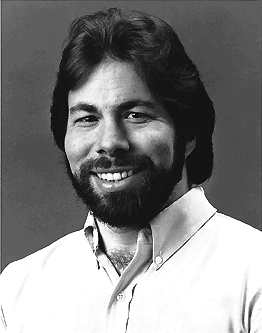![]()
|
STEPHEN WOZNIAK Have you ever benefited from an Apple I or Apple II computer? If so, there is someone you should thank. Stephen Wozniak, co-founder of the universally known Apple computer along with Steve Jobs , would gladly accept your appreciation for his work. However, unlike Jobs, he does not need it. Throughout the beginning and during his work with Apple computers, Wozniak never asked for a pat on the back. In fact, he was a little reluctant to even begin the now billion dollar company. But as most of you would agree, Wozniak is certainly happy with his decision. Currently, Wozniak has left Apple computers. Yet, he will presumably be most recognized for his contributions to the personal computer industry. The idea for the Apple I computer came about after Wozniak realized
current computers could be improved. In the Homebrew Computer
Club meetings he attende As mentioned above, Wozniak had no intention of creating a computer
business. Jobs, on the other hand, had other notions. Along with
the guidance of financial help of Mike Markkula, retired businessman,
the business began to flourish (215). The two began promoting
their soon-to-be industry at the Homebrew Computer Club meetings.
Fortunately, their machine impressed retailer Paul Terrell. Terrell
then purchased 50 Apple I computers under a certain condition.
Wozniak and Jobs were to fully assemble the computers. This task,
although it required many Wozniak, however, did not celebrate for long. That same summer Wozniak started to work on another computer, the Apple ll. "It would be a complete computer with a keyboard and power supply, BASIC, and color graphics all built into an attractive case" (213). Jobs insisted on inflating the price of the machine to make more money. Wozniak disagreed. Finally, the two decided on Wozniak's concept of a fair price. Wozniak's life was fine for the moment. However, problems began to arise. After a plane crash in 1981, Wozniak drifted away from Apple. When he returned, Jobs had a new pet project, the Macintosh. At a following stockholders' meeting, Jobs's Macintosh became the topic of discussion. Jobs seemed to forget all about Wozniak's Apple ll ("Steve Wozniak is Tired of All Play and No Work", 67). Later that month, Wozniak departed from Apple because of differences with the management. Later projects by Wozniak have shown sparks of imagination. For instance, Wozniak's CL9 ("cloud nine") started in February of 1985, introduced CORE. It was an infrared remote control capable of operating any piece of a home entertainment system. This concept revealed Wozniak's ability to appeal to the people. Wozniak also joined with Nolan Bushnell to form TechForce. Their project included robots. The toys could be "directed by audio signals encoded in the sound tracks of television programs or video cassettes" ("Toy Soldiers Go High-Tech", 54). Unfortunately, these projects never received the universal success of Bill Gates's Microsoft corporation. Stephen Wozniak, along with Steve Jobs, created a billion dollar corporation from virtually nothing. Wozniak's desire to design and build a computer that was affordable and useful is extremely admirable. Even more fascinating is Wozniak's ability to understand the needs of the society as a whole. |
 d, Wozniak introduced his first step in constructing a computer-the
programming language. BASIC, his new programming language, was
an instant success among his fellow members. Following that event,
Wozniak knew that after he placed BASIC on the 6502 microprocessor
he would "'zap the world with it'"(Fire in the Valley, 212). Wozniak
then designed and built a board that would connect to the keyboard
and the monitor. As can be expected, the computer was a hit. The
title Apple I came about, basically, because of the lack of a
better name. Although some would say, Jobs coined the name after
the Beatles's record label Apple (212).
d, Wozniak introduced his first step in constructing a computer-the
programming language. BASIC, his new programming language, was
an instant success among his fellow members. Following that event,
Wozniak knew that after he placed BASIC on the 6502 microprocessor
he would "'zap the world with it'"(Fire in the Valley, 212). Wozniak
then designed and built a board that would connect to the keyboard
and the monitor. As can be expected, the computer was a hit. The
title Apple I came about, basically, because of the lack of a
better name. Although some would say, Jobs coined the name after
the Beatles's record label Apple (212).